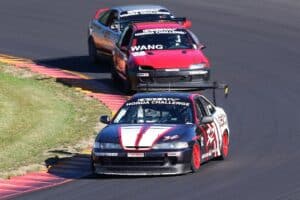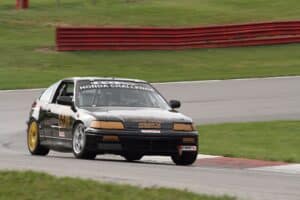
Everything You Wanted to Know About NASA's Honda Challenge Racing Series
Honda Challenge offers a tight rules structure for close competition among a variety of donor cars from which to choose. Honda Challenge consists of H1, H2 and H4 classes, in “Limited Preparation,” “Factory Preparation” and “Restricted Preparation” vehicles, which are open to Hondas and Acuras. There is a lot of variety in the horsepower and weight of the different cars eligible for Honda Challenge, so even though the rules structure is tight, you still have the freedom to build the kind of car that either you prefer or the kind of car that excels on tracks in your region.
The NASA Honda Challenge Series was created to meet the needs of Honda/Acura owners looking for a series specifically tailored to accommodate a wide range of Honda and Acura vehicles and components.
The following rules are not guidelines for this class but an actual listing of the allowed and the required modifications. If these rules do not expressly state a modification is allowed, it is prohibited. No item, which is allowed, shall also perform a prohibited function. The driver is responsible for vehicle legality.
In H1 Hybrid, vehicles are classified by engine type and drive-wheel configuration only.
In H2 “Limited Preparation” vehicles, all Honda and Acura cars with the following engines: D15, D16, B16, B16B CTR, B17, B18A, B18B, B18C, B18C1, B18C5, B20B, H22, H23 (non VTEC), F20B, F22, F23, K20A2, K20A3, K20Z1, K20Z3, K24A1, K24A2, K24A4. Parts requirements, maximum compression ratios and vehicle weights apply.
In H2 “Restricted Preparation” vehicles, all Acura RSX, 2006-2012 Honda Civic, 2004-2008 Acura TSX, 2015 and up Acura TLX with 8DCT transmission, and 2013 and up Acura ILX with six-speed transmission and 2016 and up Honda Civic with L15B engines.
In “Factory Preparation” H2 vehicles, all 2000-2009 Honda S2000.
In “Factory Preparation” H4 vehicles, all 1986 to 2001 Acura Integra, 1990 to 2002 Honda Accord, 1988 to 2011 Honda Civic, all Honda CRX, 1996 and 1997 Honda Del Sol, 1988 to 1996 Honda Prelude and 2001 and up Honda Fit.
Horsepower — 140 to 215, depending on model
Compression ratio — 9.8:1 to 12.7:1, depending on model
Average cost to run a weekend
From $800 to $1,200 including fuel and entry fees.
Tires, size, brand and prices
Toyo Proxes RR, max width of 235 mm From $188 for a 205-50-15 to $239 for a 235-40-17 Maximum wheel width for H2 and H4 vehicles below 2,600 pounds is 7 inches. Maximum wheel width for H2 and H4 vehicles 2,601 pounds and more is 8 inches.
Brakes, brands and prices
Big brake kits allowed, driver preference on pads, Hawk, Cobalt, Carbotech, etc. $122 to $200 for fronts, which last about three events or more, depending on car weight $125 to $150 rears, which last a full season
Check the NASA Contingencies page for the latest programs.
Honda Challenge Resources
Questions and Answers to Feed Your Curiosity
We have three different classes and, depending on the region, the popularity is different. SoCal is popular with H2 and H4 , the East Coast regions have more H2 or H1. Nationwide, H2 is the most popular class and is consistently represented in the NASA National Championships.
In the past, pre-2000 chassis were preferred because of the double wishbone suspension. However, newer chassis are making their way into the classes, some of which are resetting lap records.
Swaps are legal in all classes. Rules define what type of engine will be legal to use as a swap.
Competition is high, for being a club racing class, there are drivers that can challenge any pro driver any time. Honda Challenge has always been known for having extremely competitive drivers
NASA NE, Mid-Atlantic, and SoCal have the highest car counts, however NASA SE and Texas have had steady participation for the last couple of years.
The cars are cheap, easy on consumables, and punch well above their weight compared to much more expensive classes. The balanced ruleset lets you pick your favorite car and powertrain, and if built to the rules, it will be competitive. We consider it the “sweet spot” of road racing, since it balances cost of ownership, speed, and fun.
As of right now, no.
Latest Honda Challenge News Around The Country
This one is fast, short and fun. We are onboard with NASA Mid-Atlantic Honda Challenge 2 racer Micheal Young and No. 42 Brent Bauer, who put on a […]
Whether you have a street car you run in HPDE, a fire-breathing TTU monster, or one of NASA’s many spec-class racecars, you need quality lubricants […]
Wouldn’t it be great if there were a NASA contingency and Member Benefits partner that offered rewards and discounts on hardcore racing parts we […]
As NASA’s official tire retailer, TrackDayTire.com gives NASA members immediate access to an extensive national inventory of Toyo and Hoosier DOT R […]
You never know what the weather will deliver the first of December in Georgia: warm, sunny, cold or even snow. This year the Santa’s Toy Run opened […]
What Honda Challenge Competitors Say


Get On-Board with Honda Challenge Drivers
Honda Challenge Series Contacts